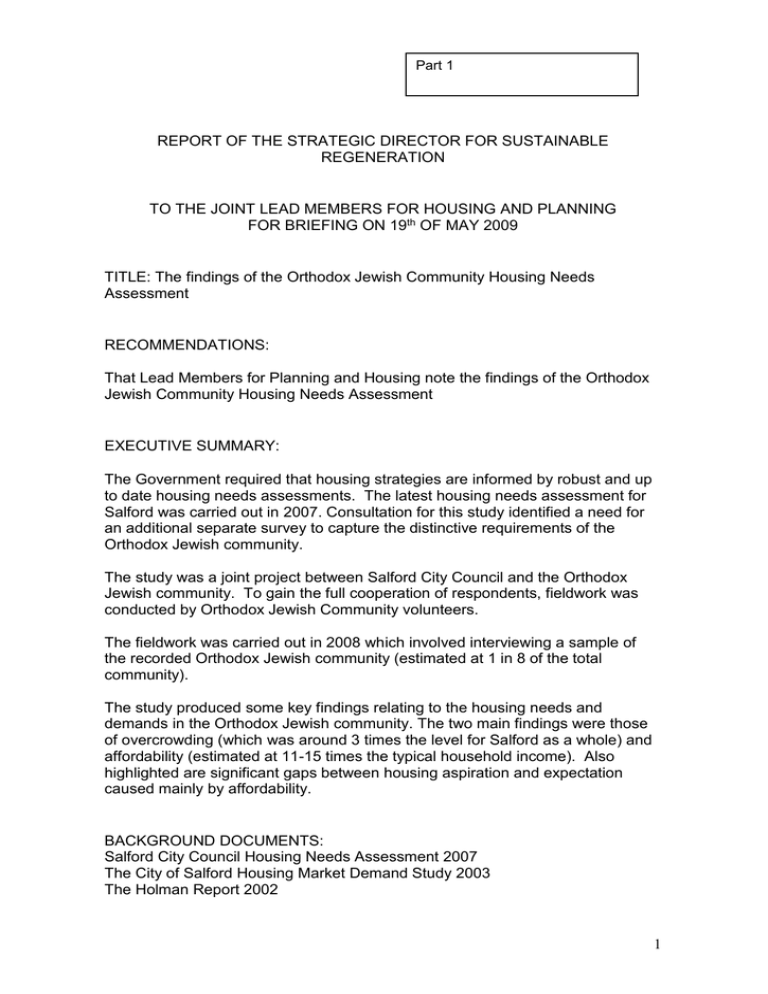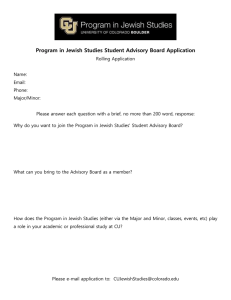REPORT OF THE STRATEGIC DIRECTOR FOR SUSTAINABLE REGENERATION
advertisement

Part 1 REPORT OF THE STRATEGIC DIRECTOR FOR SUSTAINABLE REGENERATION TO THE JOINT LEAD MEMBERS FOR HOUSING AND PLANNING FOR BRIEFING ON 19th OF MAY 2009 TITLE: The findings of the Orthodox Jewish Community Housing Needs Assessment RECOMMENDATIONS: That Lead Members for Planning and Housing note the findings of the Orthodox Jewish Community Housing Needs Assessment EXECUTIVE SUMMARY: The Government required that housing strategies are informed by robust and up to date housing needs assessments. The latest housing needs assessment for Salford was carried out in 2007. Consultation for this study identified a need for an additional separate survey to capture the distinctive requirements of the Orthodox Jewish community. The study was a joint project between Salford City Council and the Orthodox Jewish community. To gain the full cooperation of respondents, fieldwork was conducted by Orthodox Jewish Community volunteers. The fieldwork was carried out in 2008 which involved interviewing a sample of the recorded Orthodox Jewish community (estimated at 1 in 8 of the total community). The study produced some key findings relating to the housing needs and demands in the Orthodox Jewish community. The two main findings were those of overcrowding (which was around 3 times the level for Salford as a whole) and affordability (estimated at 11-15 times the typical household income). Also highlighted are significant gaps between housing aspiration and expectation caused mainly by affordability. BACKGROUND DOCUMENTS: Salford City Council Housing Needs Assessment 2007 The City of Salford Housing Market Demand Study 2003 The Holman Report 2002 1 ASSESSMENT OF RISK: There is a low level of risk – the report highlights a number of future challenges which need to be reviewed in order to provide a suitable housing offer for the Orthodox Jewish community. To mitigate this risk the implications of the findings should be taken on board and if possible addressed in relevant housing strategies and all related planning policies, documents and guidance, including overcrowding, the lack of affordability as well as access to housing related services. SOURCE OF FUNDING: There are no funding requirements for the publication of the report, although several properties may be printed. LEGAL IMPLICATIONS: Contact Officer and Extension No: Ian Sheard Ext: 3084 Date Consulted: 19/12/2008 Comments: No direct legal implications thought to be arising out of it. FINANCIAL IMPLICATIONS: Contact Officer and Extension No: Nigel Dickens Ext: 2585 Date Consulted: 7/01/2009 Comments: There are no direct financial implications arising through this report. COMMUNICATION IMPLICATIONS: A plan is in place to disseminate the findings of this needs assessment to neighbouring councils, the Manchester and Salford Pathfinder and Registered Social Landlords working in the area. In addition Interlink (the main voluntary support organisation serving the Orthodox Jewish Community) are planning to promote the document with a launch inviting other Orthodox Jewish organisations and housing associations who operate in and around the area. The report will also be distributed internally to other directorates/teams. VALUE FOR MONEY IMPLICATIONS: A considerable cost saving was achieved by using internal staff and Interlink/Binjan representatives and volunteers only to complete the project as opposed to commissioning an external research company as was originally proposed. All materials used were designed and produced in-house. CLIENT IMPLICATIONS: Not applicable 2 PROPERTY: Not applicable HUMAN RESOURCES: Not applicable CONTACT OFFICER: Michael Hemingway, Strategy & Partnerships, 793 2871 WARD(S) TO WHICH REPORT RELATE(S): The report directly relates to Kersal and Broughton along with neighbouring Bury MBC wards. KEY COUNCIL POLICIES: Unitary Development Plan – Policies ST 2 (Supply of Housing) H4 (Affordable Housing), DES 7 Amenity of Users and Neighbourhoods and DES 8 Alterations and Extensions Salford Community Plan 2006-16 – Theme 5: An inclusive city with stronger communities; Theme 7: A city that’s good to live in City Council’s 7 Pledges: Promoting Inclusion in Salford (Pledge 5), Creating prosperity in Salford (Pledge 6) and Enhancing Life in Salford (Pledge 7) Shaping Our Place 2008-2011 DETAILS: 1.0 Background 1.1 The local Orthodox Jewish community is primarily located in the Salford wards of Kersal and Broughton in an area known locally as Broughton Park. The aim of the study was to learn more about the Orthodox Jewish community’s specific housing and housing related support needs, as it was felt that a general housing needs assessment would not pick up these issues due to a having a small sample for this community and being hard to reach by nonJewish organisations. 1.2 The study was carried out by Salford City Council, in partnership with the Interlink Foundation and Binyan Housing, both of which are voluntary organisations representing the Orthodox Jewish community. Consent for the study was also given by Bury Metropolitan Council allowing it to take place across local authority 3 borders. 1.3 At the time the survey was conducted in 2008 it was estimated that the Orthodox Jewish community in Salford consisted of 8850 members, with a further 2950 in Bury and180 in Manchester. 2.0 Details 2.1 The survey was based on the questionnaire used for the general Housing Needs Study in Salford, and questions were added or tailored for the Orthodox Jewish community. In total 12% of all households were surveyed (75% of which in Salford and 25% in Bury). Trained interlink volunteers carried out the interviews on randomly selected Orthodox Jewish households identified through the community database. The data analysis and report writing was carried out solely by the Strategy and Partnerships team with input from the Orthodox Jewish community at various stages throughout development. 2.2 3.0 Main Findings 3.1 The local Orthodox Jewish community is growing at a much higher year on year rate than the wider community and is estimated to increase in size by 50% in the next 13 years based on projected birth increases and mortality rates. The average household size currently of 5.9 is around 2.5 times national and local averages. The high household size help contribute to overcrowding, which was found to be 3 times higher in the Orthodox Jewish community than in the community as a whole. Overcrowding is also the main driver of households wanting to move or moving property in the Orthodox Jewish community with ‘home too small’ being the most common factor for people who have recently moved. This was the majority reason for people needing or intending to move. 3.2 Demand for households through new household formation stands at a maximum of an additional 505 in the next five years, with up to 286 households returning from outside the area. A total of 791 (an additional 39.6%) is the estimate of new households needed in the next 5 years, and indicates the extent to which the Orthodox Jewish community is expanding through organic growth. Demand for suitably sized properties in the area is very high and this is reflected in the house prices with a property for an average required household costing between 11 and 15 times average household incomes, and is evident in the widespread affordability problem in the Orthodox Jewish community. 3.3 Housing related support needs in the Orthodox Jewish community are typical of the wider community, and whilst people with learning difficulties showed a significantly higher frequency than was recorded in the general Strategic Housing Market Assessment it is 4 possible that this is due to a misinterpretation of the question. Take-up of support services by the Orthodox Jewish community, particularly accommodation based, is likely to be problematic due to locations and ethnic sensitivity. Also access to Supporting People services by the Orthodox Jewish community is not yet recorded. There was no outstanding need identified through this study for aids and adaptations to properties to help older people, people with disabilities or other needs. However the take up of these services by the Orthodox Jewish community is also uncertain. Over a third of households indicated need or want for an extra living room for an in-built Succah, an extra kitchen (or extra units and appliances) for Pesach or both, but a further 8% indicated inability to make adaptations due to living in a flat or renting. There is demand for a very large minority of the Orthodox Jewish community for adaptations to their home which are conducive to the observation of religious periods. 3.4 The study found that there are large gaps between aspiration and expectation in the Orthodox Jewish community when buying or renting a property is concerned. The majority prefer buying a property traditionally but do not expect to be able to, and there appears to be a severe lack of affordable options to help bridge the gap. There was a preference towards Salford/Broughton Park as opposed to Bury/Prestwich as a place to live, although this could be caused by the majority of respondents living in Salford already. The study identified that there were a significant amount of Prestwich residents who would like to live in Broughton Park but did not expect this aspiration to be realised. 4.0 Conclusions 4.1 The study has provided an up to date picture of the housing needs and demands in relation specifically to the Orthodox Jewish Community in Salford. These present a number of issues which suggest there is a requirement for further considerations of the findings. It is proposed therefore that a working group is established to look at how the findings from this study can be used to address the specific housing related needs and demands of the Orthodox Jewish community in Salford. 5.0 Recommendation 5.1 It is recommended that the lead members of Planning and Housing note the findings of the Orthodox Jewish Housing Needs Assessment. 5 Paul Walker Strategic Director for Sustainable Regeneration OrthodoxJewishCom munityHousingNeedsStudy2008 -formal lm.doc 6


